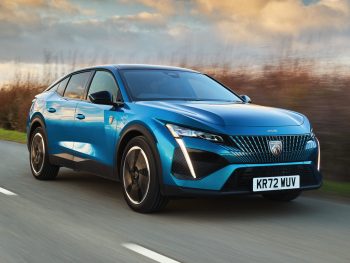Road Test: Peugeot 408 Hybrid
The French manufacturer’s first all-new model since the RCZ is a shrewd move, believes John Challen.

Peugeot 408 Hybrid
In an automotive group the size of Stellantis, brands are under pressure not only to deliver in terms of sales, but also stand out against their stablemates. One way to do that – especially in a increasingly congested SUV landscape – is to offer something a little bit different.
In truth, 408 is a good-looking car that does indeed offer something a bit different. Sitting on the popular EMP2 platform, the car is available with PHEV and ICE options, with an all-electric version following. It is very much seen within the business as a conquest car – with opportunities presenting themselves from within the C and D segments.
Sitting 4cm higher than a standard C-segment car, 408’s increased ground clearance and ‘commanding driving position’ may make a lot of drivers feel they are not missing out by jumping on the SUV train, because they have a viable alternative. Elsewhere, rear passengers can enjoy 188mm of knee room – the most space for legs available within the entire Peugeot range. Around the whole of the car (boot space excluded) there are a total of 33 litres of storage available. Talking of the boot, the maximum volume in the hybrid is 471 litres (petrol: 536 litres), which can be increased to 1,545 litres (petrol: 1,611) when the rear seats are folded.
Spec-wise, the fastback offers plenty, much of it based around Peugeot’s i-Cockpit, which features raised ventilation – for more efficient heating and cooling – and up to eight driver profiles. The squared-off steering wheel that has become a key feature of Peugeots is retained, which adds to the ‘sporty’ feel and look of the car. Although some drivers might be put off by the fact that the top bar can get in the way of the driver display. The wide range of options include a heated steering wheel, an air purification system and massage seats.
From a safety point of view, there are a total of 30 driving aids, supported by six cameras and nine radars around the car. Innovations on the 408 include: adaptive cruise control; night vision; long-range blind spot monitoring (to 75m) and rear traffic alert. There are three grades of 408: Allure; Allure Premium and GT. As you move up the range, typically there are larger wheels, more safety packages and extra convenience features.
We drove 408 in PHEV guise, of which two options are available, one with 180hp, the other with 225hp. One 130hp petrol version is available and all three are mated to an eight-speed gearbox. The electric driving range of 40 miles (AER combined) helps 408 tuck into the 8% BiK band but, in reality, we only managed 28 miles EV driving in the real world. The 408 is a pleasant car to drive and has a dynamic element that is endearing and afforded by the new body style, compared with with many SUVs on the market. There’s limited body roll, loads of room in the cabin – front and back – and it is refined, even at higher speeds.
PFor drivers who are looking to stand out, it’s well worth considering.
IN BRIEF
WHAT IS IT? C-segment fastback hybrid
HOW MUCH? from £39,900
ECONOMY? 211.3-270.3mpg
EMISSIONS? 26g/km
Key fleet model: GT Hybrid
Pro’s: Interior space and quality; refinement
Cons: Boot isn’t huge; rear headroom limited
Seven-word summary: Perky Peugeot delivers in a new segment
Also consider: Audi Q3 Sportback / Citroën C5 X / Cupra Formentor












